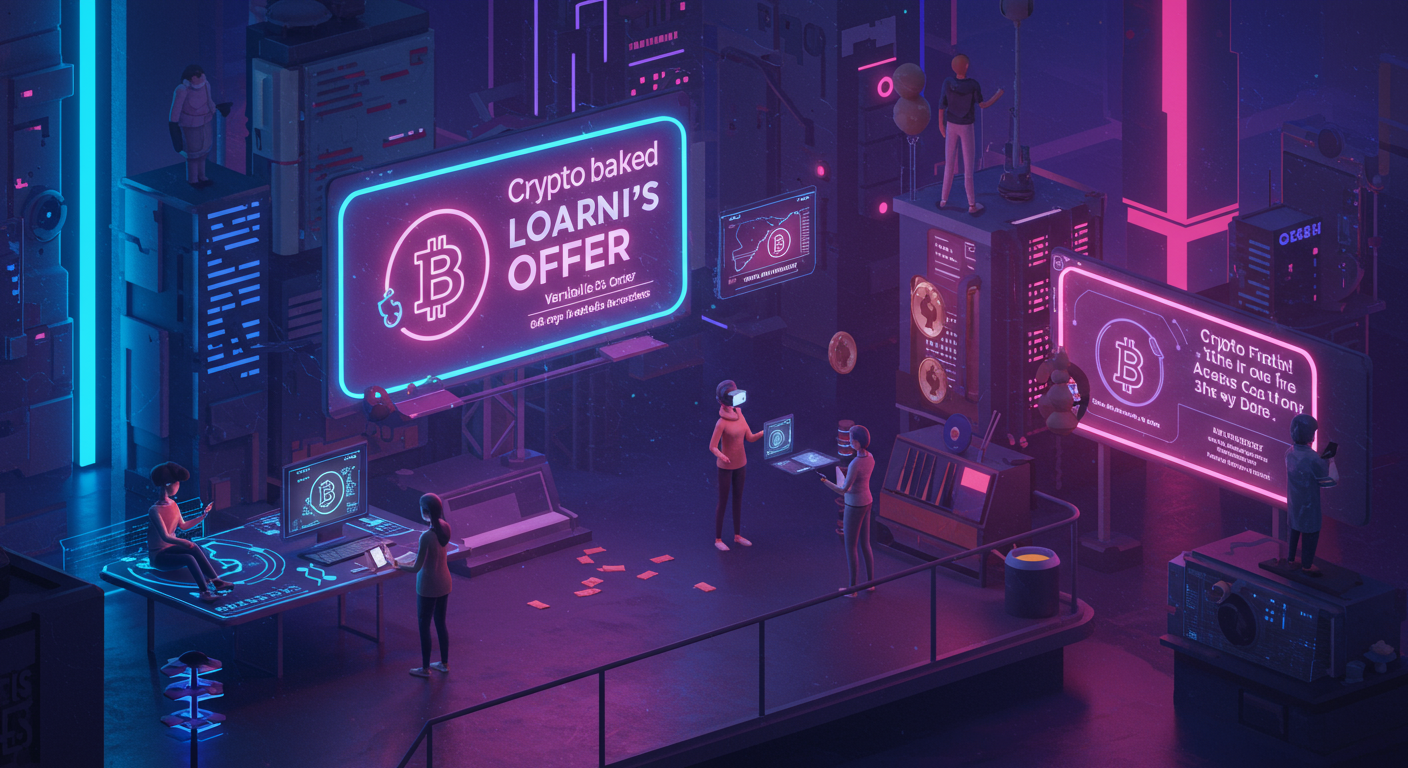Unlocking Your Crypto’s Potential: A Deep Dive into Non-Custodial, Gasless Loans
John: Alright, Lila, let’s get started. We’ve been seeing a lot of buzz lately around a new wave of financial tools in the Web3 space. The conversation is shifting from just holding crypto to actively using it without selling. The core of this revolution? The ability to get instant, crypto-backed loans in a way that’s safer and more seamless than ever before. We’re talking about a system where you can borrow against your digital assets without ever handing them over to a third party.
Lila: I’ve definitely seen the headlines, especially about partnerships like Gelato and Morpho. It sounds exciting, but also a bit intimidating. When I hear “loan,” I immediately think of banks, credit checks, and complicated paperwork. How is this different? And what does “not handing them over” even mean? It sounds like magic.
John: That’s the perfect place to start. It’s not magic, but it is a fundamental shift powered by blockchain technology. Forget everything you know about traditional banking for a moment. We’re stepping into the world of DeFi, or Decentralized Finance. Specifically, we’re unpacking three key concepts that are making this possible: crypto-backed loans, non-custodial lending, and the user-friendly magic of gasless crypto transactions. It’s a trio that promises to make borrowing as easy as using any other app on your phone, but with the powerful principles of decentralization running under the hood.

Basic Info: The Three Pillars of Modern DeFi Lending
Lila: Okay, John, break it down for me. Let’s start with the first pillar. What exactly is a “crypto-backed loan”? How does it work for a complete beginner?
John: Of course. At its simplest, a crypto-backed loan is just like a traditional secured loan, such as a mortgage or an auto loan. You provide an asset you own as collateral to secure the loan. With a mortgage, the house is the collateral. Here, your cryptocurrency—like Bitcoin (BTC) or Ethereum (ETH)—is the collateral. You lock up a certain amount of your crypto and, in return, you can instantly borrow other assets, typically stablecoins like USDC (a digital dollar).
Lila: So, if I have $10,000 worth of Bitcoin, I can use it to borrow, say, $5,000 in cash-equivalent stablecoins without selling my Bitcoin? Why would I do that instead of just selling?
John: Precisely. That’s the primary use case. Many people are long-term believers in their crypto assets. They expect the value to increase over time. Selling their BTC means they lose out on that potential future growth and create a taxable event. By taking out a loan instead, they can access liquidity (spendable cash) for daily needs, an investment, or an emergency, all while retaining ownership of their original crypto. If the price of Bitcoin goes up, they still benefit from that upside. They just have to pay back the loan with interest, of course.
Lila: That makes sense. It’s about unlocking the value of what you own without giving up the asset itself. But this brings me to my next question, which feels really important. You mentioned “non-custodial lending.” The SERP results are full of this phrase: “fully non-custodial.” What does that mean, and why is it such a big deal?
John: This is the most crucial difference between DeFi and both traditional finance and centralized crypto platforms. “Custodial” means a third party holds and controls your assets on your behalf. Your bank is a custodian for your money. A centralized crypto exchange is often a custodian for your crypto. You are trusting them to keep it safe. Non-custodial means you, and only you, retain full control over your assets at all times, even when they are locked as collateral.
Lila: How is that technically possible? If my crypto is collateral for a loan, doesn’t the lender need to have some control over it in case I don’t pay back?
John: They do, but that control is executed by code, not by a company. Your collateral is sent to a smart contract (a self-executing contract with the terms of the agreement directly written into lines of code) on the blockchain. This smart contract is an autonomous, transparent, and unchangeable program. It’s like a digital escrow service run by pure logic. It will hold your collateral securely, and no person or company can access it, move it, or misuse it. The contract’s rules are clear: if you repay your loan, your collateral is returned to you automatically. If your collateral’s value drops too much and you fail to add more collateral or repay the loan (an event called liquidation), the contract will automatically sell just enough collateral to cover the debt. You are always in control of your wallet, and you interact directly with this open-source code.
Lila: Wow. So the trust is in the code, not in a corporation that could go bankrupt or get hacked. That’s a powerful idea. Now for the third pillar, which sounds like the user-friendly cherry on top: “gasless crypto.” I’ve tried using Ethereum before, and the “gas fees” (transaction costs) were confusing and sometimes really expensive. How are they getting rid of those?
John: “Gasless” is a bit of a marketing term, but it points to a very real user experience improvement. The transactions on a blockchain like Ethereum still require a fee to be paid to the network validators. What “gasless” or “blockchain-abstracted” means is that the *user* doesn’t have to deal with it directly. The complexity is hidden. This is often achieved through a mechanism called “meta-transactions” or newer standards like EIP-4337 (Account Abstraction). Essentially, the application or a third-party service (like Gelato, which specializes in this kind of automation) pays the gas fee on the user’s behalf. They might recoup this cost through a slightly higher interest rate or a small service fee, but the user experience is transformed. No more pop-ups from your wallet asking for gas, no need to hold the network’s native token (like ETH) just to pay for transactions. It feels like using a normal web app.
Supply Details: Where Does the Money Come From?
Lila: Okay, this is starting to form a clearer picture. I put my crypto into a smart contract, I borrow stablecoins, and I don’t have to worry about gas fees. But where do those stablecoins I’m borrowing actually come from? Is there a big bank on the other side?
John: No bank. This is the “decentralized” part of DeFi. The capital comes from other users. These platforms operate on a peer-to-peer model, but it’s more sophisticated than just matching one borrower with one lender. Instead, they use something called a liquidity pool. Think of it as a big communal pot of digital money. Users who want to earn interest on their assets (like USDC) can deposit them into this pool. They become lenders, or “liquidity providers.”
Lila: So it’s a crowdsourced pool of loanable funds. What’s in it for the people who put their money in the pot?
John: They earn a yield. The interest paid by borrowers like you is distributed among all the liquidity providers in the pool, proportional to how much they contributed. The platform’s smart contract handles all of this automatically. It calculates the interest rates, collects payments from borrowers, and distributes the earnings to lenders. The interest rates are typically variable and are determined algorithmically based on supply and demand. If many people want to borrow from the pool and there’s not much capital in it, the interest rate goes up to attract more lenders. If the pool is full of capital and borrowing demand is low, the rate goes down to entice borrowers.
Lila: And how do platforms like Morpho fit into this? Are they the liquidity pool?
John: Morpho is a fascinating innovation on this model. Instead of creating its own separate liquidity pools, Morpho acts as an optimization layer on top of existing, well-established lending pools like Aave or Compound. It directly matches lenders and borrowers peer-to-peer whenever possible, which improves the interest rates for both parties. If a direct match isn’t available, it seamlessly falls back to using the underlying pool’s liquidity. So, users on Morpho get the benefit of better rates from peer-to-peer matching combined with the deep liquidity and reliability of the largest DeFi lending platforms. It’s the best of both worlds.
Technical Mechanism: Under the Hood of an Embedded Loan
John: This is where the partnership between Gelato and Morpho becomes so powerful. They are taking this highly efficient lending model from Morpho and making it incredibly easy for any application to integrate. This is what they call an “embedded crypto-backed loan.”
Lila: “Embedded” sounds like something you’d find in a news article. In tech terms, what does it mean here? That I could get a crypto loan from inside my favorite game or social media app someday?
John: Exactly. The goal is to bring these powerful DeFi services to where the users already are. Traditionally, to get a DeFi loan, you’d need to:
- Get a Web3 wallet like MetaMask.
- Buy some ETH for gas fees.
- Navigate to a complex DeFi website like Aave or Morpho.
- Connect your wallet and figure out the interface.
It’s a multi-step process that’s a huge barrier for most people.
Lila: I can confirm, that sounds like a weekend project, not a quick financial transaction.
John: Right. The Gelato-Morpho solution provides a simple toolkit, or SDK (Software Development Kit), that any developer can build into their existing wallet, fintech app, or platform. Gelato handles the complex “on-chain” parts. Here’s a simplified breakdown of the technical flow:
- User Initiates: Inside their familiar app, the user says, “I want to borrow $1,000 USDC against my BTC.”
- Smart Wallet Creation: Gelato’s infrastructure can create an on-chain “smart account” or “safe” for the user. This is a more advanced type of wallet controlled by smart contracts, which enables features like gasless transactions.
- Collateral Deposit: The user sends their BTC to this smart account. It’s still fully non-custodial; only the user can authorize transactions from it.
- Gasless Transaction Execution: The user signs a message (not a transaction, so no gas) authorizing the loan. Gelato’s network of relayers picks up this signed message, wraps it in a proper blockchain transaction, pays the gas fee, and sends it to the Morpho smart contracts.
- Loan Issuance: The Morpho contract receives the request, verifies the collateral in the user’s smart account, and instantly sends the borrowed USDC back to the user’s account.
The entire process is managed by code, happens in seconds, and from the user’s perspective, it’s just a few clicks inside one application. No wallet pop-ups, no gas fee calculations, no credit checks. It’s a completely onchain and transparent process, but with a Web2-like user experience.
Lila: That’s the missing piece for me. Gelato acts as the butler who handles all the messy blockchain interactions behind the scenes, so the user just gets the final result. And Morpho is the ultra-efficient bank vault they’re interacting with. But what about liquidation? That sounds like the scariest part. How does the smart contract know when to sell my collateral?
John: That’s the job of something called an “oracle.” An oracle is a service that feeds real-world data, like the current price of BTC, onto the blockchain so smart contracts can use it. Reputable lending platforms use highly secure and decentralized oracles like Chainlink. The Morpho smart contract constantly checks the oracle price. It knows you’ve deposited, for example, $10,000 of BTC and borrowed $5,000 of USDC. This is a 50% Loan-to-Value (LTV) ratio. The protocol has a set “liquidation threshold,” say 80% LTV. If the value of your BTC collateral drops to the point where your $5,000 loan is now worth 80% of its value, the liquidation process can be triggered by anyone. A liquidator repays a portion of your debt and, in return, gets to buy some of your collateral at a slight discount. This ensures the lender (the pool) is always made whole. It’s a ruthless but necessary and transparent mechanism to prevent bad debt in the system.

Team & Community: The Minds Behind the Innovation
Lila: So who are the teams building this? It’s important to know who is writing this crucial code.
John: Absolutely. Both teams are well-respected in the Web3 infrastructure space. Gelato Network has been around for years, establishing itself as a leader in Web3 automation. They’re known for creating reliable infrastructure that automates smart contract executions, essentially serving as the backend backbone for many decentralized applications. They are the experts in making the blockchain do things automatically and hiding its complexity from users.
Lila: So they’re the plumbers and electricians of Web3, making sure everything works behind the walls.
John: A great analogy. And Morpho Labs is the team of financial engineers and researchers who built the Morpho protocol. They are laser-focused on capital efficiency in DeFi lending. Their whitepaper and subsequent protocol launches have been well-received by the developer community for their innovative approach to improving interest rates. They’re seen as pushing the theoretical boundaries of what’s possible in on-chain lending. The community’s reaction to this partnership has been overwhelmingly positive, as it pairs a top-tier automation protocol with a top-tier lending protocol to solve a very real problem: user experience.
Use-Cases & Future Outlook: Beyond the Crypto Bubble
Lila: We’ve talked about the “how,” but let’s talk about the “why.” What are some real-world use cases for these embedded, gasless loans? Is it just for crypto traders?
John: That’s where it starts, but it’s certainly not where it ends. The immediate applications are clear:
- Fintech Apps and Neobanks: Imagine a digital banking app like Revolut or Chime being able to offer a new feature: “Instantly borrow against your crypto.” It becomes just another service alongside stock trading or savings accounts.
- Crypto Wallets: Wallets can move from being passive storage to active financial hubs. You could take a loan directly from your wallet interface to pay for something without having to send your crypto to an exchange and sell it.
- Brokerages: Platforms where you buy and sell crypto can now offer lending services, creating a stickier ecosystem for their users.
Lila: So it’s about making crypto a more useful, integrated part of the financial world we already use. What about looking further into the future? What could this enable?
John: The long-term vision is truly transformative. Think about creators in the Metaverse who earn NFTs or other digital assets. They could borrow against the value of those assets to fund their next project. Or a small business in a developing country with unstable local currency could hold its treasury in a stablecoin and use other crypto assets as collateral to get short-term working capital loans, all without needing access to a traditional bank, which might be impossible for them. Because it’s a fully onchain and non-custodial system governed by smart contracts, it’s borderless and permissionless. It removes the biases and gatekeeping of the traditional financial system. There are no credit checks because the loan is over-collateralized by the crypto you already own. Your creditworthiness is determined by your assets, not your personal history or location.
Competitor Comparison: Old World vs. New Code
Lila: How does this stack up against the competition? Not just other DeFi protocols, but the old way of doing things?
John: Let’s look at three main competitors.
- Traditional Banks: To get a secured loan from a bank, you need a good credit score, proof of income, and to go through a lengthy application process. It can take days or weeks. The bank acts as a custodian and has opaque internal processes. With a non-custodial crypto loan, approval is instant, there are no credit checks, and the rules are transparently coded into a smart contract.
- Centralized Crypto Lenders (CeFi): Think of now-infamous companies like BlockFi or Celsius. They offered a simple user experience but operated like black-box banks. They were custodial, meaning they took control of your crypto. When they made bad investments or went bankrupt, users lost everything. This is the exact risk that non-custodial lending is designed to eliminate. With the Gelato/Morpho model, your collateral is always in a smart contract you control, not on a company’s balance sheet.
- Other DeFi Lending Protocols: Protocols like Aave and Compound are the pioneers and the foundation upon which Morpho is built. They are the direct competitors, but also collaborators. The key differentiators for the new embedded solutions are the improved user experience via gas abstraction (thanks to Gelato) and potentially better rates (thanks to Morpho’s peer-to-peer matching). It’s less about replacing them and more about building a more user-friendly front door to access their liquidity.
Risks & Cautions: Nothing is Risk-Free
Lila: This all sounds incredible, almost too good to be true. As a journalist, I have to ask: what are the risks? What could go wrong?
John: An essential question. The technology is powerful, but it’s not without risks. Users must understand them.
- Smart Contract Risk: While the code is the law, what if there’s a bug or a flaw in the code? Sophisticated hackers could potentially exploit it to drain funds. This is why using protocols that are heavily audited by third-party security firms and have been battle-tested over time is critical.
- Oracle Risk: The system relies on oracles for accurate price data. If an oracle is manipulated or provides incorrect data, it could trigger wrongful liquidations. This is why decentralized and robust oracle networks are non-negotiable for a safe lending platform.
- Liquidation Risk: This is the biggest risk for the user. If the market for your collateral crashes suddenly and you don’t have time to add more collateral or repay your loan, you will be liquidated. You’ll lose your collateral (at a slight penalty) and keep the funds you borrowed. You must not over-leverage and should always maintain a healthy collateralization ratio.
- Systemic Risk: The DeFi ecosystem is highly interconnected. The failure of one major protocol could have cascading effects on others. Morpho mitigates this somewhat by building on top of established platforms, but the risk is never zero.
These systems offer great power and autonomy, but that comes with great responsibility. There’s no customer service line to call to reverse a transaction if you make a mistake.

Expert Opinions & Analyses
Lila: What’s the general sentiment from industry experts on this “embedded” trend?
John: The consensus is that abstracting away blockchain complexity is the key to mass adoption. An analyst I follow, a Dr. Anya Sharma who specializes in DeFi usability, recently said, “For years, we’ve been building powerful engines without thinking about the driver’s seat. Solutions that embed DeFi into familiar interfaces, using gas abstraction and smart accounts, are finally building the dashboard and steering wheel. This isn’t just an improvement; it’s the prerequisite for the next hundred million users.” The focus is shifting from “how the blockchain works” to “what you can do with it,” which is a sign of a maturing industry.
Latest News & Roadmap
Lila: So, this Gelato and Morpho announcement is the big news right now. What’s next on their roadmap?
John: The initial launch focuses on making it easy for developers to integrate these loans. The next steps, as hinted at in their announcements, will likely involve expanding to more blockchains beyond Ethereum and its Layer 2s, supporting a wider range of collateral assets (not just BTC and ETH), and further refining the user experience. The ultimate goal is to make this embedded lending primitive a standard, ubiquitous piece of financial plumbing across the entire Web3 ecosystem. The announcement is the starting gun for a race to see which applications can integrate these powerful new tools most effectively for their users.
FAQ: Quick Answers to Common Questions
Lila: Let’s wrap up with a quick FAQ section. I’ll fire off some questions a reader might have.
John: Sounds good. Go ahead.
Lila: 1. Is this the same as staking my crypto?
John: No. Staking usually involves locking your crypto to help secure a blockchain network (like with Ethereum’s Proof-of-Stake) and earning rewards. Lending involves providing your crypto as collateral to borrow against it or depositing it into a pool to earn interest from borrowers. They are different financial activities with different risks and rewards.
Lila: 2. What happens if I want to pay back my loan early?
John: You can pay back your loan, in part or in full, at any time. There are no prepayment penalties. Once you repay the borrowed amount plus the accrued interest, the smart contract will automatically release your collateral back to your wallet.
Lila: 3. Do I need to do KYC (Know Your Customer)?
John: For the decentralized protocol itself, no. Because the loan is fully secured by your crypto collateral, there’s no need for the protocol to know your real-world identity or run a credit check. However, the front-end application you use (the fintech app or exchange) might have its own KYC requirements to comply with local regulations.
Lila: 4. What’s the minimum amount I can borrow?
John: This depends on the platform, but DeFi is generally very flexible. Loans can often be for very small amounts, far smaller than what a traditional bank would ever consider. The system is designed to be accessible.
Lila: 5. Is the interest rate fixed or variable?
John: In most DeFi lending protocols, including Morpho, the interest rates for both borrowing and lending are variable. They change in real-time based on the supply and demand within the liquidity pools. This ensures the market is always in equilibrium.
Related Links & Final Thoughts
John: We’ve covered a lot of ground today, from the basics of crypto-backed loans to the cutting-edge tech making them seamless and accessible. The key takeaway is this: the ability to borrow against your digital assets in a fully non-custodial, transparent, and user-friendly way is a financial game-changer. The friction of high gas fees and complex interfaces is being systematically eliminated by infrastructure providers like Gelato, while capital efficiency is being perfected by protocols like Morpho. This is moving DeFi from a niche for experts to a powerful tool for everyone.
Lila: It’s a huge step forward. It makes the assets people hold in the digital world more useful in the real world, without forcing them to sell or give up control. The future of finance is clearly becoming more open, automated, and embedded into the technology we use every day. It will be fascinating to watch which apps are the first to bring this to millions of users. Thanks for breaking it all down, John.
John: My pleasure, Lila. It’s a complex but exciting frontier. As always, for anyone reading, please remember that this article is for educational purposes only and is not financial advice. The world of DeFi involves significant risks, and you should always do your own thorough research (DYOR) before interacting with any protocol or investing your funds.
